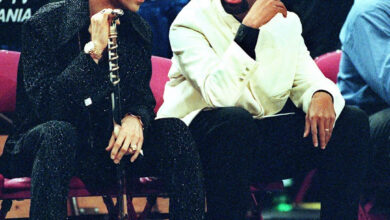Rod Stewart’s Idols Were the Soundtrack to His Rise to Fame! Discover Which Legends Shaped His Career and Made Him the Icon He Is Today
OPINION: This article may contain commentary which reflects the author's opinion.
Rod Stewart’s raspy voice, distinct style, and unparalleled stage presence have earned him a place in rock and roll history. But behind every great musician stands a set of influences that helped shape their sound, and for Rod Stewart, his idols weren’t just inspirations—they were the backbone of his rise to fame. In this article, we explore the musical legends who shaped Stewart’s journey to becoming one of the most iconic voices of his generation.
1. Sam Cooke: The Soulful Blueprint
It’s impossible to talk about Rod Stewart’s vocal style without mentioning Sam Cooke, the legendary soul singer whose smooth yet powerful delivery became Stewart’s blueprint for emotive performance. Stewart once said that hearing Cooke sing for the first time was like a “religious experience.” He studied Cooke’s phrasing and emotional depth, making sure to incorporate those qualities into his own music. The raw soul that permeates Stewart’s hits like “Maggie May” and “Reason to Believe” owes much to Cooke’s influence.
2. Otis Redding: Channeling Raw Emotion
Rod Stewart also found a kindred spirit in Otis Redding, another soul giant known for his impassioned performances. Redding’s ability to convey heartache and joy through his voice inspired Stewart to dig deeper emotionally in his own songs. Tracks like “You Wear It Well” capture that same level of raw intensity that Redding brought to classics like “Try a Little Tenderness.” It’s clear that Stewart not only admired Redding but sought to channel that same soulful power in his performances.
3. Bob Dylan: The Master of Storytelling
Rod Stewart’s foray into songwriting took inspiration from none other than Bob Dylan. Known for his poetic lyrics and unconventional vocal style, Dylan showed Stewart that singing wasn’t just about hitting the perfect note; it was about telling a story. Stewart embraced this narrative approach, crafting songs that resonated with listeners on a personal level. Hits like “Mandolin Wind” and “Every Picture Tells a Story” reflect that Dylan-esque approach to songwriting, blending lyrics with a story that pulls fans into a world of love, loss, and reflection.
4. The Rolling Stones: Bringing the Rock Edge
While soul music shaped Stewart’s voice, it was The Rolling Stones who brought the rock ‘n’ roll swagger into his performances. Watching Mick Jagger command the stage showed Stewart how to fuse blues with rock, creating a sound that felt both timeless and fresh. That influence is evident in Stewart’s work with the Jeff Beck Group, where his raspy vocals became the perfect complement to Beck’s fiery guitar riffs. His later solo work, including tracks like “Hot Legs” and “Stay With Me,” capture that Stones-like grit that became synonymous with rock rebellion.
5. Al Jolson: Early Inspirations
Before discovering rock and soul, a young Rod Stewart was captivated by the theatrical performances of Al Jolson. Known for his charisma and larger-than-life stage presence, Jolson inspired Stewart to bring a level of showmanship to his performances that would leave audiences wanting more. It’s no surprise that Stewart became known for his flamboyant outfits, high-energy concerts, and rapport with fans—qualities that can be traced back to his early fascination with Jolson’s magnetic stage persona.
6. Chuck Berry: The Pioneer of Rock ‘n’ Roll
When it comes to the roots of rock, Chuck Berry was a pioneer, and Rod Stewart soaked up every riff and rhythm Berry created. Berry’s blend of blues, country, and rhythm and blues laid the foundation for the sound Stewart would later adopt. It’s impossible to listen to Stewart’s work in The Faces without hearing the direct line from Berry’s groundbreaking tracks like “Johnny B. Goode” and “Roll Over Beethoven.” Berry’s influence also helped Stewart understand the importance of crafting songs that would stand the test of time—something Stewart has mastered throughout his five-decade career.
7. Etta James: The Queen of Blues
Etta James’ powerful and soulful vocals taught Stewart how to tap into the raw emotions needed to captivate an audience. Stewart has openly cited her as one of his vocal inspirations, and it’s clear that her style influenced his ability to convey both vulnerability and strength in his songs. Her deep-rooted blues influence can be heard in Stewart’s later forays into more soulful and emotional ballads, such as “I Don’t Want to Talk About It.”
8. Little Richard: The King of Energy
Few artists could match the raw energy of Little Richard, whose wild performances and infectious enthusiasm left an indelible mark on Rod Stewart. From Richard, Stewart learned that music was as much about entertaining as it was about singing. Stewart brought that same explosive energy to the stage, making his concerts feel like full-blown celebrations of rock and roll. Songs like “Do Ya Think I’m Sexy?” may not sound like Little Richard’s early hits, but the same energy that propelled “Tutti Frutti” is undeniably present.
Conclusion: A Musical Mosaic
Rod Stewart’s journey to stardom wasn’t forged in isolation—it was a tapestry of influences woven together from the sounds of rock, soul, and blues. From the soul of Sam Cooke and Otis Redding to the rebellious rock of The Rolling Stones and Chuck Berry, Stewart borrowed from the greats to create a sound that was unmistakably his own. These idols didn’t just shape his music; they helped him become the icon we know today—an artist whose songs continue to resonate with generations of fans.
So the next time you hear “Maggie May” or “Tonight’s the Night,” remember, you’re not just hearing Rod Stewart—you’re hearing the echoes of the legends who paved the way for his enduring legacy.



